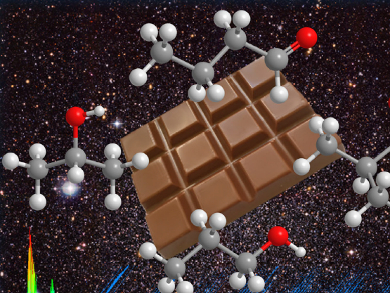Complex organic molecules (organic molecules containing six or more atoms) are ubiquitous in star- and planet-forming regions as well as on comets such as 67P/Churyumov-Gerasimenko. The latter was confirmed using the Rosetta space probe. However, the molecules’ origins have remained largely unexplained until now.
Ralf I. Kaiser, University of Hawai’i at Manoa, Honolulu, HI, USA, and colleagues have achieved the first laboratory detection of distinct C3H8O (propanol, methyl ethyl ether) and C4H8O (n-butanal, i-butanal) isomers formed within interstellar-analog ices through interaction with ionizing radiation. Some of these compounds are, for example, responsible for the flavor of chocolate.
The team used an ultrahigh-vacuum (UHV) surface-science chamber at pressures of a few 10−11 torr to simulate the conditions in the interstellar medium. Under these conditions, they exposed ices of isotopically labeled carbon monoxide (13CO) and methane (13CD4) to energetic electrons at 5 K. The reactions were monitored using Fourier Transform Infrared (FTIR) spectroscopy.
The researchers found that complex organics with propyl and butyl groups can be synthesized easily in deep space under the influence of galactic cosmic rays. These processes are of vital importance in initiating a chain of chemical reactions leading to complex organic molecules—not only in the interstellar medium, but also on comets.
- On the Synthesis of Chocolate Flavonoids (Propanols, Butanals) in the Interstellar Medium,
Matthew J. Abplanalp, Sándor Góbi, Alexandre Bergantini, Andrew M. Turner, Ralf I. Kaiser,
ChemPhysChem 2018.
https://doi.org/10.1002/cphc.201701350
Also of Interest
- How Amino Acids Formed in the Universe,
Vera Koester, Uwe Meierhenrich,
ChemViews Mag. 2015.
https://doi.org/10.1002/chemv.201500104
Professor Meierhenrich, France, about his involvement in the Rosetta mission and its importance for chemists



